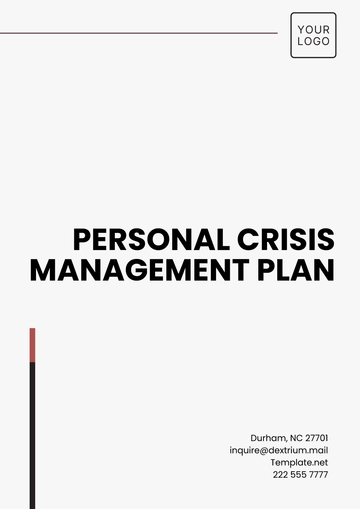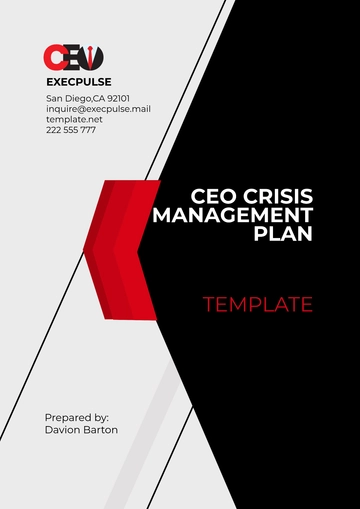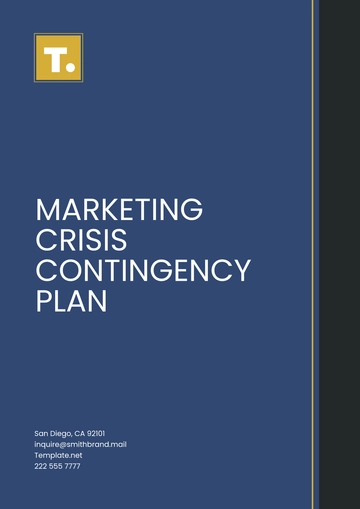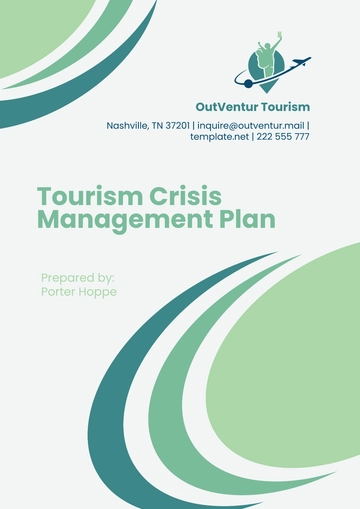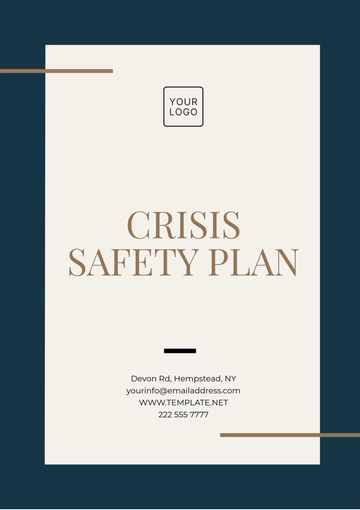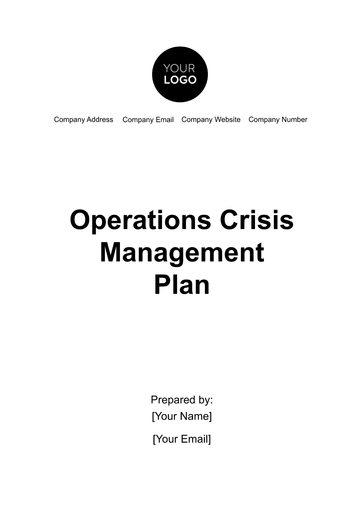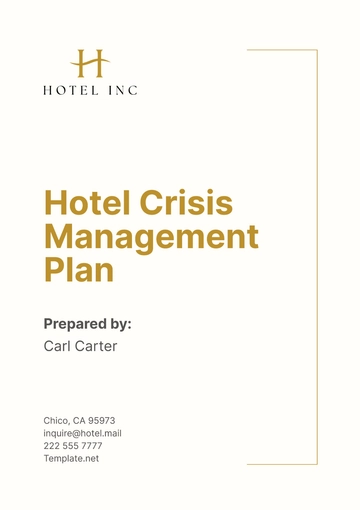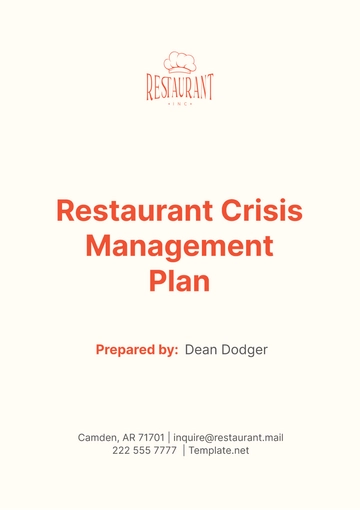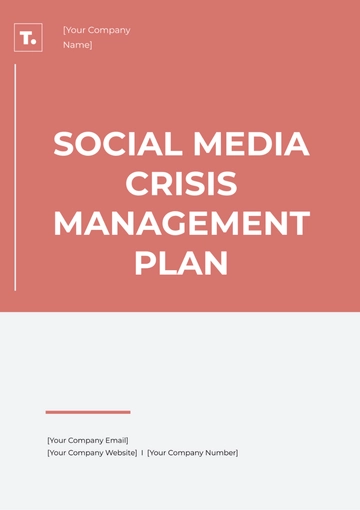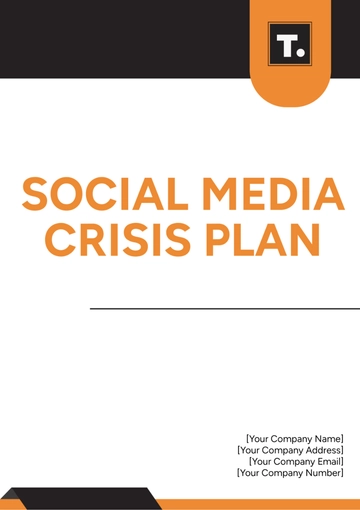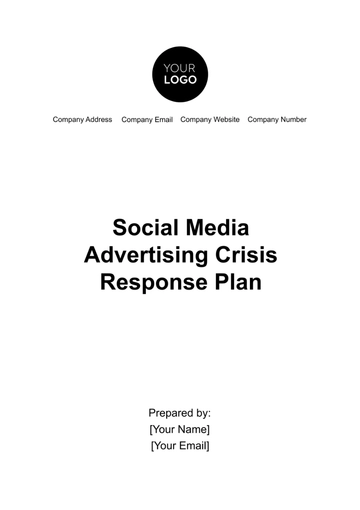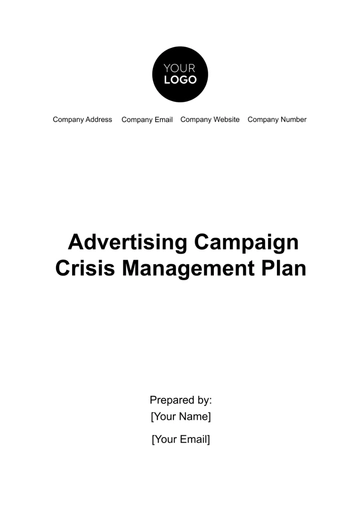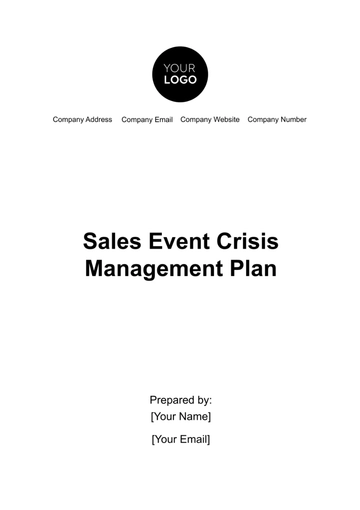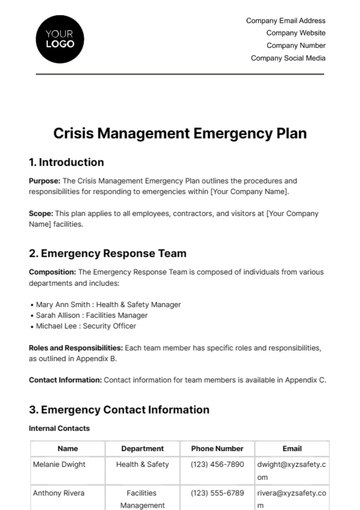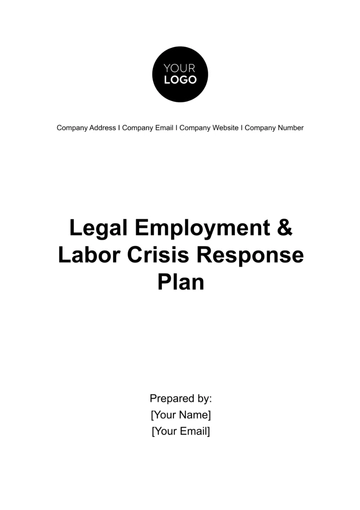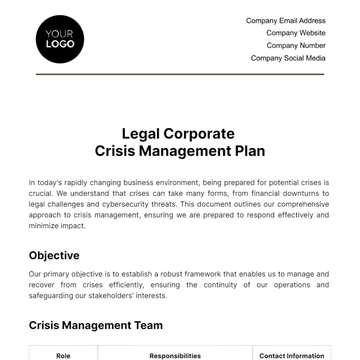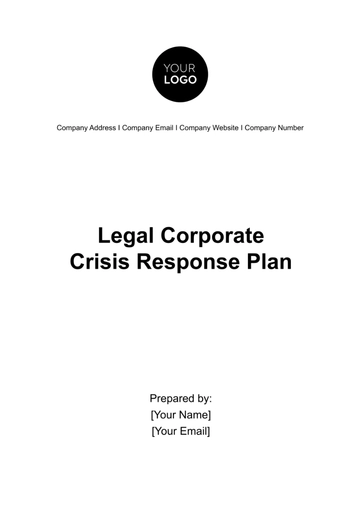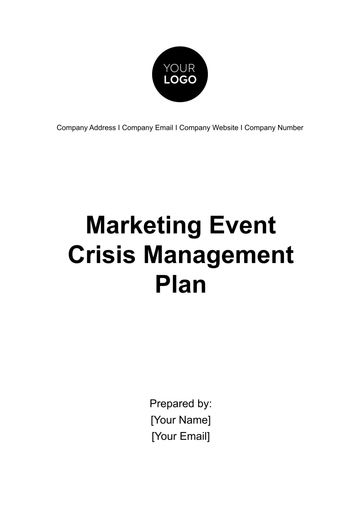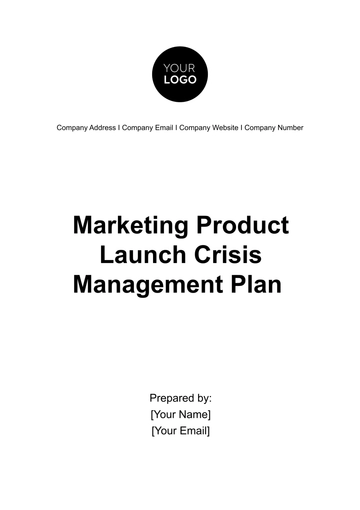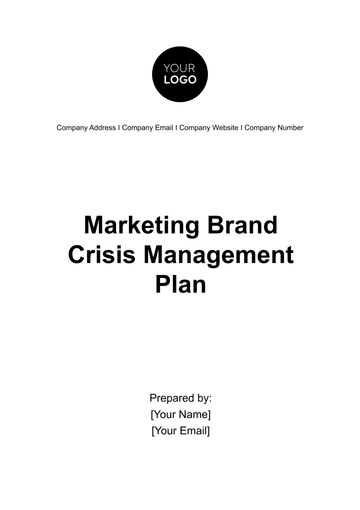Free Marketing Brand Crisis Management Plan
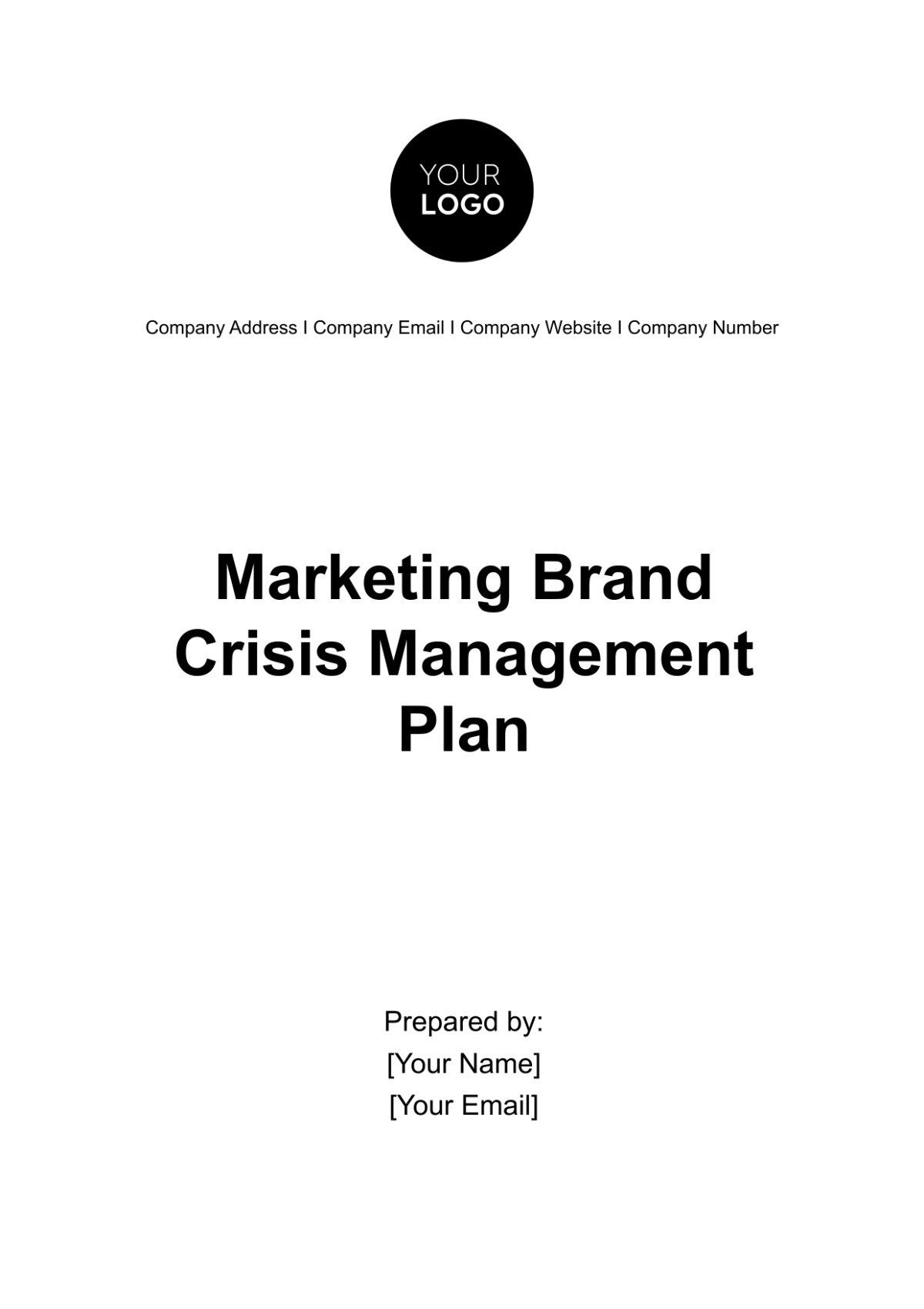
1. Introduction
In an ever-evolving global marketplace, even the most formidable and established brands aren't immune to unexpected challenges and setbacks. From sudden technological disruptions to unforeseen reputational threats, crises can emerge from various quarters. Recognizing this, the objective of this Crisis Management Plan is not just to react but to proactively prepare. For [Your Company Name], safeguarding our legacy, brand reputation, and the trust we've painstakingly built with our stakeholders is paramount. This document outlines a structured and strategic approach, ensuring that no matter the nature or scale of the crisis, our response is swift, coordinated, and effective. Beyond just addressing the immediate concerns, our plan also lays the groundwork for recovery and future prevention. Through this comprehensive roadmap, [Your Company Name] aims to reinforce its commitment to excellence, resilience, and unwavering dedication to its stakeholders, even in the face of adversity.
2. Crisis Identification & Categorization
In our commitment to proactively manage potential threats, understanding the nature and type of crises is crucial. Different crises demand distinct responses, and by categorizing them, we can tailor our reactions accordingly, ensuring efficiency and precision. The following table breaks down various crisis types that [Your Company Name] might encounter, providing a brief description and an illustrative example for each. This categorization serves as the foundation for our subsequent strategies and response protocols, allowing us to swiftly pinpoint the nature of an issue and activate the relevant crisis management procedures.
Type of Crisis | Description | Example |
Operational | Pertaining to disruptions or malfunctions in the daily functions or processes of the business. | Supply chain disruptions might result from supplier issues, transportation challenges, or unforeseen global events. |
Financial | Pertaining to monetary challenges that impact the company's economic health and stability. | A sudden stock drop could be due to negative earnings reports, market shifts, or global economic downturns. |
Reputational | Concerning events or situations that might harm the public perception and image of the brand. | Negative publicity might arise from a controversial company decision, public incidents, or unsatisfactory products/services. |
Technological | Involving crises that result from IT failures, security breaches, or technological malfunctions. | Data breaches can compromise customer data, resulting in loss of trust and potential legal ramifications. |
Natural | Refers to uncontrollable events caused by natural forces that might impact the company's operations. | Natural disasters like hurricanes or earthquakes can disrupt manufacturing, supply chains, or physical store operations. |
By understanding and preparing for each type of crisis, [Your Company Name] stands better equipped to address challenges head-on, minimizing potential damage and ensuring a quicker path to recovery.
3. Communication Strategy & Protocols
Effective communication is the lifeblood of crisis management. During turbulent times, the manner in which [Your Company Name] communicates can significantly influence the perception and impact of the situation. It's not just about relaying facts, but also about demonstrating responsibility, empathy, and a commitment to resolution. This chapter outlines the fundamental protocols that govern our communication strategy during crises, ensuring that our stakeholders receive timely, accurate, and consistent information that upholds the brand's values and integrity.
Immediate Response: Time is of the essence during a crisis. An immediate acknowledgment of the situation is critical. Even if full details are still emerging, a prompt acknowledgment can mitigate speculation and demonstrate that [Your Company Name] is actively managing the situation. By addressing the issue within the first 24 hours, we show proactiveness and a sense of responsibility, reassuring our stakeholders that we are in control and taking necessary steps.
Transparency: In an era where information is abundant, offering clear, concise, and truthful details is paramount. Concealing facts or offering vague explanations can erode trust. [Your Company Name] commits to being transparent, providing stakeholders with as much factual information as possible and updating them as the situation evolves. This approach not only builds credibility but also fosters a sense of trust and reliability during challenging times.
Consistency: Inconsistent messages can breed confusion and mistrust. It's essential that regardless of the platform—be it press releases, social media, or internal communications—the messaging remains unified. [Your Company Name]'s dedicated communication team collaborates to ensure that every piece of information, every update, and every statement aligns with the overall narrative, maintaining the brand's integrity and coherence.
By adhering to these communication protocols, [Your Company Name] ensures that its responses during crises are not only effective but also reflect the brand's commitment to honesty, responsibility, and its stakeholders' well-being.
4. Crisis Response Team
In the heart of any crisis, the composition, expertise, and decisiveness of the response team play a pivotal role in shaping the outcome. These individuals are not just representatives but the pillars upon which [Your Company Name]'s response strategy rests. Their collective experience, knowledge, and leadership ensure that every decision made is in the best interest of the company, its stakeholders, and its brand reputation. The following table provides an overview of our dedicated Crisis Response Team, highlighting their roles, names, and specific responsibilities:
Role | Name | Responsibility |
Team Lead | [Person's Name] | As the helmsperson steering the ship during a crisis, the Team Lead oversees the overall strategy and decision-making process. They ensure all departments collaborate efficiently, while also having the final say on major decisions, ensuring the brand's best interests are always prioritized. |
Communications Head | [Person's Name] | The Communications Head is the voice of [Your Company Name] during tumultuous times. Tasked with crafting and disseminating messages, they liaise with media and manage stakeholder communications, ensuring clarity, consistency, and transparency in every word. |
Legal Advisor | [Person's Name] | Crises often come with legal implications. The Legal Advisor navigates these waters, offering guidance on legal ramifications, potential liabilities, and the best course of action to ensure [Your Company Name]'s actions are always within the boundaries of the law. |
IT Lead | [Person's Name] | In our digital age, technological crises are a growing concern. The IT Lead is at the forefront of managing such situations, from data breaches to system outages. Their expertise ensures swift resolutions, minimizing disruptions and safeguarding sensitive data. |
HR Lead | [Person's Name] | The HR Lead focuses on the company's most valuable asset—its people. From internal communications to ensuring the well-being of staff, they play a crucial role in maintaining morale and cohesion during trying times. |
Having a dedicated and proficient Crisis Response Team allows [Your Company Name] to respond to challenges with agility, decisiveness, and coherence, ensuring that even in the face of adversity, our brand stands resilient and steadfast.
5. Stakeholder Communication Plan
In the maze of crisis management, the right communication can be the beacon that guides stakeholders through the uncertainty. Each group of stakeholders holds a unique relationship with [Your Company Name], and their concerns, questions, and expectations differ. Tailoring our communication strategy to resonate with each group ensures that they remain informed, reassured, and aligned with our crisis response measures. This chapter delves deep into our bespoke communication strategies for various stakeholder groups, ensuring clarity and continuity at every touchpoint:
Internal Staff: The backbone of [Your Company Name], our internal staff, plays a crucial role during crises. It's paramount to keep them in the loop, as they are often the first point of contact for external queries. Regular email updates provide them with the latest information, ensuring they feel supported and equipped to handle any external communications. Additionally, frequent team meetings or virtual briefings can be organized to address any concerns and gather feedback.
Customers: Our customers are central to our business. During crises, they seek reassurance and clarity regarding how the situation might impact them. Addressing their concerns proactively is key. Announcements on our website provide a central information hub, while personalized email communications offer more specific details. Social media platforms, with their vast reach and immediacy, serve as vital channels to broadcast updates, address queries, and engage with the customer base.
Investors: Investors have a vested interest in [Your Company Name]'s well-being and performance. During turbulent times, they require transparent, timely, and comprehensive updates about the crisis's impact on business operations and financial health. Regular communications through official channels—like investor relation portals, official press releases, and dedicated investor webinars—ensure they remain informed and confident in [Your Company Name]'s crisis management capabilities.
Suppliers: Suppliers are integral to our operational chain. Whether there are disruptions in supply, changes in demand, or any other operational shifts, maintaining open lines of communication with our suppliers is essential. Regular updates, be it through phone calls, emails, or virtual meetings, ensure they are aligned with any changes in our operations and can adjust their processes accordingly.
Understanding and addressing the unique needs of each stakeholder group underscores [Your Company Name]'s commitment to transparency, trust, and collaboration. Through this comprehensive Stakeholder Communication Plan, we ensure that every concerned party remains well-informed, supported, and confident in our brand's resilience and response strategy.
6. Media & Public Relations Strategy
In times of crisis, the spotlight on [Your Company Name] intensifies, and every statement, action, or silence is scrutinized by the media and the public at large. Handling this heightened attention requires a well-thought-out strategy, ensuring that our communications not only convey factual information but also reflect our brand's commitment to transparency, responsibility, and resolution. This chapter outlines [Your Company Name]'s approach to managing media and public relations during crises, detailing specific protocols designed to uphold our reputation and provide clear, consistent information.
Media Blackout: The initial stages of a crisis are often marked by uncertainty, with facts still emerging and the situation evolving. During this period, it's essential to prevent the spread of unverified information or speculation. A media blackout ensures that no unofficial communication regarding the crisis is released, providing [Your Company Name] with the time and space needed to gather accurate information and formulate a coherent response. All staff and representatives are advised to refrain from making statements to the media until official communications are in place.
Official Statements: The cornerstone of our media strategy is the official statement. Crafted with precision, it encapsulates the known facts of the situation, [Your Company Name]'s response, and any other pertinent details. Prepared by the Communications Head, each statement undergoes rigorous review to ensure its accuracy, clarity, and alignment with [Your Company Name]'s values. Before release, the Team Lead approves it, ensuring a unified and strategic message.
Press Conferences: For significant crises or when the situation demands direct media engagement, press conferences are organized. Led by the Communications Head, these events offer a platform to address the media's questions directly, provide updates, and outline [Your Company Name]'s action plan. By doing so, [Your Company Name] not only manages the narrative but also demonstrates its proactive approach and commitment to transparency.
Navigating the complex terrains of media relations during a crisis is challenging. Yet, with a structured strategy in place, [Your Company Name] is poised to manage media interactions with finesse, ensuring that our brand's image remains intact, and our stakeholders are accurately informed, irrespective of the challenges we face.
7. Post-Crisis Analysis & Recovery
After navigating through the immediate challenges of a crisis, it's essential for [Your Company Name] to look back and reflect. This post-crisis phase is not just about recovery, but also about growth and fortification. Analyzing the events, understanding the outcomes, and implementing lessons learned ensures that we emerge stronger, more resilient, and better prepared for future challenges. This chapter delves into the systematic approach [Your Company Name] adopts post-crisis, ensuring that every adversity is transformed into an opportunity for enhancement and development.
Review: Once the immediate effects of the crisis have been managed, a thorough review is conducted. This involves a detailed analysis of the events leading up to the crisis, the immediate response, and its effectiveness. Questions like "What were the early warning signs?" and "How effectively did our response mitigate the impact?" are addressed. By understanding the root causes and evaluating the response efficacy, [Your Company Name] ensures that similar issues can be preempted or better managed in the future.
Learn: Every crisis, despite its challenges, offers valuable lessons. It's imperative for [Your Company Name] to document these lessons meticulously. Whether it's recognizing a gap in our crisis management plan, understanding a communication shortfall, or identifying areas of operational improvement, these insights form the bedrock of our continuous improvement efforts. Regular workshops or debriefing sessions are conducted to discuss, document, and internalize these lessons, ensuring they become an integral part of our future strategies.
Rebuild: A crisis can dent the brand's image, customer trust, and stakeholder confidence. Recovery is not just about resuming operations but also about restoring faith. [Your Company Name] implements robust recovery strategies, ranging from rebuilding brand reputation through targeted campaigns, engaging with stakeholders to address concerns, and reinforcing trust through transparent communication and actions. Our commitment to our stakeholders goes beyond mere transactions; it's about forging lasting relationships, and our recovery efforts underscore this dedication.
The post-crisis phase is a testament to [Your Company Name]'s unwavering commitment to excellence and its stakeholders. By reviewing, learning, and rebuilding, we ensure that every challenge faced is transformed into a stepping stone, propelling us towards a brighter, stronger future.
8. Review & Update Schedule
In an ever-evolving business landscape, what works today might not be as effective tomorrow. Recognizing this dynamism, it's crucial for [Your Company Name] to ensure that our Crisis Management Plan remains not only current but also anticipatory. We are committed to a regular review and update schedule. Every [specific period, e.g., "six months"], our dedicated team revisits this plan, assessing its effectiveness in the light of recent events, emerging risks, and changing business scenarios.
Moreover, the aftermath of any crisis offers a wealth of insights. Post-crisis evaluations provide invaluable lessons, revealing areas of improvement and highlighting strengths. It's imperative that these insights are integrated into our plan. By combining regular time-bound reviews with reactive updates post-crisis, [Your Company Name] ensures that our Crisis Management Plan is always at the cutting edge, ready to address challenges with agility, foresight, and efficiency. This iterative approach underscores our dedication to continuous improvement, safeguarding our brand's reputation, and ensuring stakeholder trust, irrespective of the challenges ahead.
This Crisis Management Plan serves as a foundational guide for [Your Company Name] to navigate unforeseen challenges, ensuring that our brand remains resilient, trustworthy, and robust in the face of adversity.
- 100% Customizable, free editor
- Access 1 Million+ Templates, photo’s & graphics
- Download or share as a template
- Click and replace photos, graphics, text, backgrounds
- Resize, crop, AI write & more
- Access advanced editor
Crafted by Template.net, our Marketing Brand Crisis Management Plan Template is a lifeline for businesses facing turbulence. Seamlessly editable and fully customizable, this tool ensures tailored strategies for every crisis. With the added convenience of our Ai Editor Tool, fortify your brand against storms with confidence and precision.
You may also like
- Finance Plan
- Construction Plan
- Sales Plan
- Development Plan
- Career Plan
- Budget Plan
- HR Plan
- Education Plan
- Transition Plan
- Work Plan
- Training Plan
- Communication Plan
- Operation Plan
- Health And Safety Plan
- Strategy Plan
- Professional Development Plan
- Advertising Plan
- Risk Management Plan
- Restaurant Plan
- School Plan
- Nursing Home Patient Care Plan
- Nursing Care Plan
- Plan Event
- Startup Plan
- Social Media Plan
- Staffing Plan
- Annual Plan
- Content Plan
- Payment Plan
- Implementation Plan
- Hotel Plan
- Workout Plan
- Accounting Plan
- Campaign Plan
- Essay Plan
- 30 60 90 Day Plan
- Research Plan
- Recruitment Plan
- 90 Day Plan
- Quarterly Plan
- Emergency Plan
- 5 Year Plan
- Gym Plan
- Personal Plan
- IT and Software Plan
- Treatment Plan
- Real Estate Plan
- Law Firm Plan
- Healthcare Plan
- Improvement Plan
- Media Plan
- 5 Year Business Plan
- Learning Plan
- Marketing Campaign Plan
- Travel Agency Plan
- Cleaning Services Plan
- Interior Design Plan
- Performance Plan
- PR Plan
- Birth Plan
- Life Plan
- SEO Plan
- Disaster Recovery Plan
- Continuity Plan
- Launch Plan
- Legal Plan
- Behavior Plan
- Performance Improvement Plan
- Salon Plan
- Security Plan
- Security Management Plan
- Employee Development Plan
- Quality Plan
- Service Improvement Plan
- Growth Plan
- Incident Response Plan
- Basketball Plan
- Emergency Action Plan
- Product Launch Plan
- Spa Plan
- Employee Training Plan
- Data Analysis Plan
- Employee Action Plan
- Territory Plan
- Audit Plan
- Classroom Plan
- Activity Plan
- Parenting Plan
- Care Plan
- Project Execution Plan
- Exercise Plan
- Internship Plan
- Software Development Plan
- Continuous Improvement Plan
- Leave Plan
- 90 Day Sales Plan
- Advertising Agency Plan
- Employee Transition Plan
- Smart Action Plan
- Workplace Safety Plan
- Behavior Change Plan
- Contingency Plan
- Continuity of Operations Plan
- Health Plan
- Quality Control Plan
- Self Plan
- Sports Development Plan
- Change Management Plan
- Ecommerce Plan
- Personal Financial Plan
- Process Improvement Plan
- 30-60-90 Day Sales Plan
- Crisis Management Plan
- Engagement Plan
- Execution Plan
- Pandemic Plan
- Quality Assurance Plan
- Service Continuity Plan
- Agile Project Plan
- Fundraising Plan
- Job Transition Plan
- Asset Maintenance Plan
- Maintenance Plan
- Software Test Plan
- Staff Training and Development Plan
- 3 Year Plan
- Brand Activation Plan
- Release Plan
- Resource Plan
- Risk Mitigation Plan
- Teacher Plan
- 30 60 90 Day Plan for New Manager
- Food Safety Plan
- Food Truck Plan
- Hiring Plan
- Quality Management Plan
- Wellness Plan
- Behavior Intervention Plan
- Bonus Plan
- Investment Plan
- Maternity Leave Plan
- Pandemic Response Plan
- Succession Planning
- Coaching Plan
- Configuration Management Plan
- Remote Work Plan
- Self Care Plan
- Teaching Plan
- 100-Day Plan
- HACCP Plan
- Student Plan
- Sustainability Plan
- 30 60 90 Day Plan for Interview
- Access Plan
- Site Specific Safety Plan
